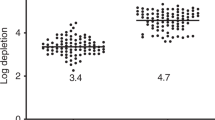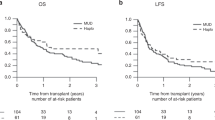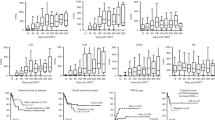Abstract
Marrow transplantation from unrelated donors has been linked with an increased risk of graft-versus-host disease (GVHD). In an attempt to lower the risk of acute GVHD we used CD34 marrow cell selection for T cell depletion. Since T cell depletion has been linked to an increased risk of relapse and an increased risk of marrow failure, we used PCR amplification of minisatellite sequences to investigate donor cell engraftment and RT-PCR amplification of recurrent chromosomal translocations to investigate the residual disease post-transplant. Twenty-three patients who underwent BMT after positive selection of the CD34-positive cell population were studied. Results were then compared with those of 37 patients who underwent transplantation with unmanipulated marrow graft. Among the 23 patients who received CD34+ selected cell grafts, seven (30%) had evidence of full donor engraftment, 14 had evidence of residual recipient cells (61%), one had a non-take, and one autologous bone marrow recovery. Analysis of the chimaerism status post-transplant in 36 patients who received unmanipulated marrow grafts showed that 31 patients (86%) had evidence of full donor engraftment. The difference in the incidence of mixed chimaerism profile between patients who received unmanipulated marrow graft and those receiving CD34+ selected cell grafts was statistically significant (P < 0.01). nine patients who received cd34+ selected cell grafts could be analysed for the presence of minimal residual disease post-transplant (one with t(9;22) acute lymphoblastic leukaemia and eight with CML). In the patient transplanted for a Ph-positive acute leukaemia, and in two out of the eight patients with CML, the search fora fusion transcript was consistently negative after transplantation. Among the six patients with evidence of residual disease, three patients also had a mixed chimaerism profile and were given donor lymphocyte infusions. Minimal residual disease study was performed post-transplant in 16 patients who received unmanipulated marrow grafts. In 10 of 14 patients with CML, and in two patients with acute leukaemia the search for a fusion transcript was consistently negative after transplantation. The difference in the incidence of minimal residual disease between patients who received an unmanipulated marrow graft and those receiving CD34+ selected cell grafts was not statistically significantly significant, but numbers of patients included in this analysis are still few. In conclusion, our study highlights the strong influence of graft manipulation on the incidence of mixed chimaerism after transplantation from an unrelated donor.
This is a preview of subscription content, access via your institution
Access options
Subscribe to this journal
Receive 12 print issues and online access
$259.00 per year
only $21.58 per issue
Buy this article
- Purchase on Springer Link
- Instant access to full article PDF
Prices may be subject to local taxes which are calculated during checkout
Similar content being viewed by others
Author information
Authors and Affiliations
Rights and permissions
About this article
Cite this article
Socié, G., Cayuela, J., Raynal, B. et al. Influence of CD34 cell selection on the incidence of mixed chimaerism and minimal residual disease after allogeneic unrelated donor transplantation. Leukemia 12, 1440–1446 (1998). https://doi.org/10.1038/sj.leu.2401110
Received:
Accepted:
Published:
Issue Date:
DOI: https://doi.org/10.1038/sj.leu.2401110
Keywords
This article is cited by
-
Chimerism analysis within 6 months of allogeneic stem cell transplantation predicts relapse in acute myeloid leukemia
Bone Marrow Transplantation (2007)
-
Analysis of haematopoietic chimaerism by quantitative real-time polymerase chain reaction
Bone Marrow Transplantation (2005)
-
Serial quantification of lymphoid and myeloid mixed chimerism using multiplex PCR amplification of short tandem repeat-markers predicts graft rejection and relapse, respectively, after allogeneic transplantation of CD34+ selected cells from peripheral blood
Leukemia (2003)



